DONNIE DARKO: Third Theatrical Time Is An Unwavering Charm
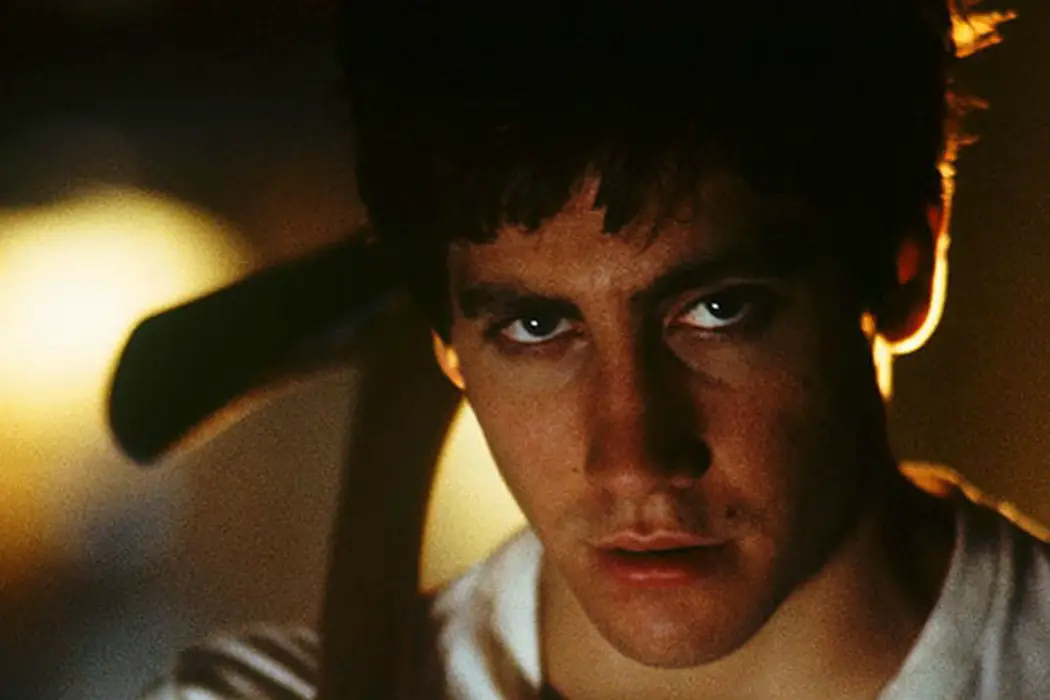
Alex Arabian is a freelance film journalist and filmmaker. His…
On March 31, 2017, both the original and director’s cut versions of Donnie Darko were released theatrically for a third time in the US, this time with writer and director Richard Kelly and his director of photography, Steven Poster, restoring the film in dazzling 4k resolution.
Kelly’s first film, Donnie Darko (2001), is among cinema’s more impressive debuts. Though the then 26-year-old writer and director’s film was a box office failure at first, it was critically well received and had a small but loyal fanbase that would eventually expand to the general public in years to come. Indeed, Donnie Darko is widely considered to be the first cult classic of the 21st century. Shot on an estimated budget of $4.5 million, the film made just over $500,000 over a five-month stretch in the US when it first hit theaters in 2001. It appeared the film was more well-received worldwide, garnering more than $2.5 million.
Strong DVD sales prompted Newmark Cinemas to distribute a refined director’s cut, granting Kelly $290,000 to add additional elements to the film that the studio previously inhibited him from doing. The new edition included 20 minutes of extra footage comprised of all the deleted scenes on the DVD extras, a refined soundtrack (with INXS’s Never Tear Us Apart to open the film instead of Echo & the Bunnymen’s The Killing Moon, which would remain within the movie in a later scene, heard on a car radio in the background) and enhanced audio and digital production (including additional CGI effects such as the chest spheres that Donnie envisions during his prophecies). It also included text from the fictional novel in the film, The Philosophy of Time Travel, written by the character, Roberta Sparrow – or “Grandma Death” – as Donnie and his friends called her.
The film earned an additional $1.3 million at the box office in the US, and when the director’s cut DVD was released, it pushed total DVD and Blu-ray sales to $10 million. Donnie Darko is a convention-defying film on many levels, but in an industry sense, it is rare for a film to be modified and released in theaters at the behest of its studio solely because of DVD sales, and then to succeed even better than its first theatrical release.
Donnie Darko did not garner much buzz during its promotion before the first release in 2001 because of its at-the-time unknown director, Kelly, and its obscure cast. Drew Barrymore and Patrick Swayze were the two most recognizable actors, but their star power was not enough to intrigue most audiences. Noah Wyle was a television actor known for E.R., and the Gyllenhaal siblings, Seth Rogen (in his film debut) and Jena Malone were still relatively unknown aside from a few minor TV and film roles. However, this film catapulted Jake Gyllenhaal into stardom and immediately established a precedent for his knack for playing odd, unhinged characters.
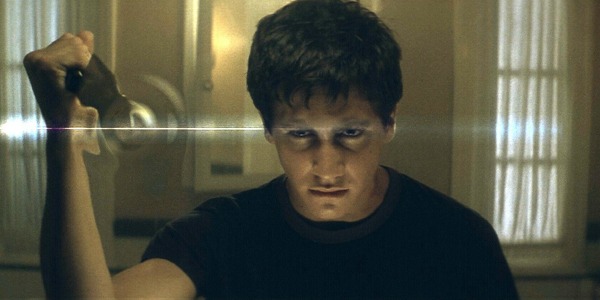
The film takes place in 1988 in a fictional suburban upper-middle-class town in America called Middlesex, set against the political backdrop of Michael Dukakis and George H.W. Bush’s presidential race. The first line of the film is: “I’m voting for Dukakis.” Though politics take a back seat to more religious, cultural, and societal motifs and themes, this line not only establishes the film’s playful nods to irony, but it sets the tone for its conservative critique from the liberal point of view. This ranges from commentary throughout about the inefficiency and fear-inducing tactics of the private Catholic school system, to highlighting the resurgence of isolationism and the ignorant bubble that white American suburban life begets during the ’80s (one of the many lingering negative effects of Ronald Reagan’s presidency), to criticizing the pervasiveness of institutional sexism and racism – especially in Catholic schools, where sexuality is repressed – to conveying the collective unease of a post-Cold War era hysteria prompted by Reagan’s emergence on the national political stage.
Gyllenhaal plays the titular character who avoids a catastrophic jet engine crash in his room because he sleepwalked elsewhere, waking up on top of a hill. Donnie is a troubled kid, underperforming in school despite exceptional test scores. He meets Gretchen Ross (Malone), the new student at his Catholic high school. Gretchen is attracted to his oddness. Donnie also bonds with his school teachers Karen Pomeroy (Barrymore) and Professor Monnitoff (Wyle), who are represented as the last of a dying breed of teachers that truly care about encouraging positive change in their uniformed students in an otherwise indifferent school. Professor Monnitoff, along with Grandma Death (Patience Cleveland), are integral in helping Donnie find out his intended path set by Frank (James Duval).
Donnie begins seeing visions of Frank, a man in a giant rabbit costume, who only appears near a water source, and explains to Donnie that he is the main instrument in a plan to save the end of the world in 28 days. During their conversations, Frank and Donnie frequently break the fourth wall. Manipulating Frank, Donnie compels him to perform increasingly destructive and dangerous acts such as breaking the water pipes in the school and burning down Jim Cunningham’s (Swayze) house. Yet, these acts of destruction lead to revelatory discoveries that change the fate of several characters. Donnie sees right through Jim, who is a local celebrity due to his successful self-help videos.
Kitty Farmer (Beth Grant) is Jim’s loyal follower, a schoolteacher, leader of the PTA, and coach of Donnie’s younger sister, Samantha’s (Daveigh Chase) cheerleading squad. Donnie consistently argues with Kitty, rebelling against her teaching criteria, based on Jim’s philosophies, which she follows like scripture. Real-life sister to Jake, Maggie Gyllenhaal plays Elizabeth Darko, who embraces Donnie’s weirdness. However, Donnie’s parents, Rose and Eddie (Mary McDonnell and Holmes Osborne), send Donnie to psychiatrist Dr. Thurman (Katharine Ross) once his sleepwalking worsens and he begins seeing visions of Frank.
Donnie is put on medication to control his “delusions.” Shades of white middle-class racism are sprinkled throughout the film, as Donnie’s friends repeatedly make fun of Chinese student Cherita Chen (Jolene Purdy), who has a crush on Donnie. Donnie knows this and treats her with kindness and solidarity. Donnie is a progressive in a conservative breeding ground of hypocrisies, which is why he is chosen as “god’s instrument” in the film.
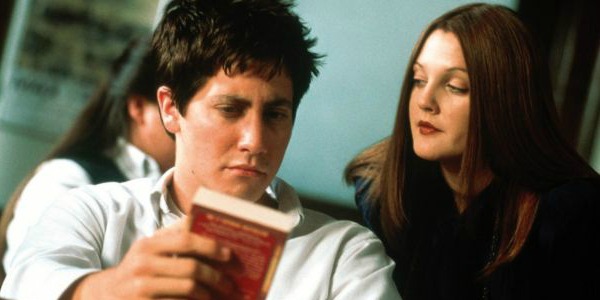
Kelly’s film may seem like an out-there, experimental piece of indie, arthouse cinema whose reach exceeded its grasp, but he was able to make the film he wanted to. Every detail poured into the film adds to its intricate, layered symbolism and recurring motifs; it’s a painstaking masterclass in the importance of applying detail to create not only a believable period piece, but also a science-fiction film that’s grounded in realism.
In the context of what is happening in the world today, Donnie Darko is littered with foreboding and foreshadowing easter eggs and references that past viewers might have missed. For this reason, the film has stood the test of time. Many of these references are common knowledge among the die-hard internet community of the “Darko” cult that is its loyal fanbase, but the following paragraphs will tie further connections to, draw parallels with, add deeper meanings to and provide context for some of these facts and references, as well as add a new perspective to a cult classic.
Political References and Undertones
One week after Donnie Darko’s climax, George H.W. Bush was elected president. One of Donnie’s bullies is named Ricky Danforth (Rogen). His surname is a reference to James Danforth Quayle, who served as Bush Sr.’s Vice President. In the scene where Donnie is suspended from school for busting the water pipes, there’s a photo of Ronald Reagan on the bookcase as the camera glides from Principal Cole to Kitty Farmer.
At the Halloween party, in homage to a famous Hunter S. Thompson photograph, someone wearing a Ronald Reagan mask and a white cape is jumping on the trampoline. In the original photo, Thompson is wearing a Nixon mask to express his hatred for him, calling him “that dark, venal, and incurably violent side of the American character.” Kelly updates this recreation to match the decade and to draw the authoritarian parallels between Nixon and Reagan. Kelly slips these references of Reagan and Bush Sr. into the film to establish an undertone of the aforementioned political and social unease during the late ’80s as a result of a regressive government stemming from detrimental conservative ideologies.
The Devil Is in the Digits
When Donnie starts seeing the man dressed in a bunny suit from the future named Frank, he tells Donnie that the world will end in 28 days, 6 hours, 42 minutes and 12 seconds. The sum of these numbers is 88, the speed needed for the DeLorean in Back To The Future to achieve time travel. 1988 was the year that Martin Scorsese’s The Last Temptation Of Christ was released, whose controversial portrayal of a sexually active, human Christ parallels Donnie’s sacrificial fate. It was also the year Stephen Hawking’s A Brief History of Time was published, which explored, among other things, time travel.
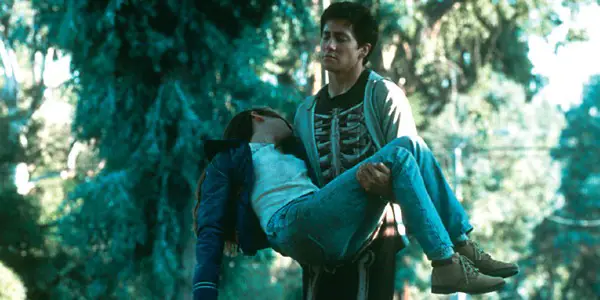
In physics, the string theory is the theoretical study of time-space wherein the universe is portrayed as a series of dimensions tied together by cosmic strings, or frequencies, caused by vibrations found in nature. It is often used to found theorems about gravity, different dimensions, black holes and time travel. There are two kinds of heterotic strings, one being the heterotic E8 × E8. Much of Donnie’s conversations with Professor Monnitoff consist of these theories, which are also discussed in Grandma Death’s book concerning opening and closing portals, or “strings,” in the universe.
In the Bible, Wisdom 8:8 explains: ‘And if a man desire much knowledge: she knoweth things past, and judgeth of things to come: she knoweth the subtleties of speeches, and the solutions of arguments: she knoweth signs and wonders before they be done, and the events of times and ages.” The Book of Wisdom is a deuterocanonical, or secondary canon scripture, classified by the Roman Catholic Church in the 1500s, meaning it is a passage taken from the Old Testament Bible that was not included in the Hebrew Bible. In Bible scripture, Wisdom is often personified as a woman having divine power and infinite knowledge of time.
Frank, in the context of Donnie Darko, is Wisdom personified; instead of likening this personification to a woman, Kelly likens it to a giant rabbit likely for stylistic reasons. As Rose and Samantha Darko prepare to load their plane back home from Samantha’s cheerleading competition, the airport announces that their flight number is 2806, they are boarding at gate 42, and the red-eye flight is at 12:00 AM. Suffice it to say, Kelly put a considerable amount of thought into each set piece and its minute details. The film was shot in 28 days, almost the exact deadline Frank gave Donnie.
There is another theory about the amount of time Frank gives Donnie to save the world. The length of the lunar month is precisely 27 days, 7 hours, 43 minutes, and 11 seconds. Subtract one digit to the first three numbers, and add one to the last number, and you have Frank’s timeline, just before the lunar completion of the lunar month. “The killing moon, will come too soon,” as the Echo and the Bunnymen lyrics play, but we’ll get to the foreshadowing later.
Perhaps most interesting about the deconstruction of Frank’s timeline, is that three were subtracted, and one was added. Donnie’s disruption of god’s plan causes three deaths: Frank’s, Gretchen’s, and Jim Cunningham’s reputation’s figurative death. By sacrificing himself, Donnie reversed these three drastic causalities, furthering his Christ comparison. Ultimately, three were added at the expense of one, completing the lunar month in a figurative, mathematical sense.
Pop Culture References & Influences
Kelly cheekily pays homage to film inspirations and members of the cast and strategically places many ‘80s pop culture references. The decade oozes from April Ferry’s impeccable costume design in minute details such as Donnie’s Levi’s button-fly jeans or various staples of children’s toys such as the Slinky, Rubik’s Cube, or Hungry Hungry Hippos, all popularized in the ‘80s.
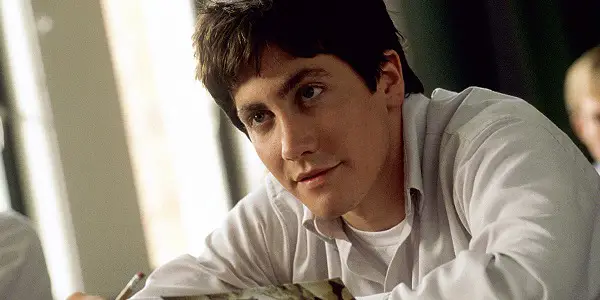
Kelly’s script also contains hilarious references to the at-the-time highly watched Smurfs. As well as the influence Kelly took from The Last Temptation of Christ through the visuals of the opening scene, toward the end of the film, the bike ride sequence to Grandma Death’s house is a nod to Steven Spielberg’s E.T., which launched Drew Barrymore’s career. Elizabeth Darko’s Halloween costume is a reference to Vivian Darkbloom (played by Marianne Stone), a character in Stanley Kubrick’s Lolita. During the PTA meeting, Kitty Farmer denounces the credibility of author Graham Greene by appearing on the television show Bonanza. Of course, she is confusing him with actor Lorne Greene, in a comical moment in the film.
Donnie refers to Jim Cunningham as a “Chud,” a reference to the film C.H.U.D. The acronym stands for Cannibalistic Humanoid Underground Dweller. Though Cunningham does not literally feed on the flesh of others, his pedophilia urges him to prey on the flesh of young children. Gretchen, Donnie and Frank attend a screening of Sam Raimi’s cult horror classic, The Evil Dead, as part of a double-feature, coupled with, you guessed it, The Last Temptation Of Christ, during the film.
These pop culture references exist stylistically, to accentuate the period piece, and to help ground the story of the otherwise seemingly absurdist plot of Donnie Darko.
Foreshadowing Throughout the Film
Kelly payed much attention to foreshadowing what was to come throughout the film. Though, one would never notice all of his hints in the first several viewings. A red sports car passes Donnie as he is riding his bike home in the beginning scene. The driver of the vehicle, Gretchen’s murderer, is not revealed until the end of the movie on Halloween.
During the The Evil Dead screening, Frank, Donnie and Gretchen are the only three people in the theater, and the only people who experience death in the film. Toward the film’s end, Donnie and his friends ride their bikes to Grandma Death’s house, and Donnie’s bike is the only one without a headlight, foreshadowing his inevitable fate.
In the “Cunning Visions” promotional commercial, Jim Cunningham rewards one of his child students by patting his behind. This foreshadows Jim’s child pornography collection revelation that Donnie would unwittingly uncover by burning down his home under Frank’s orders. According to Jim, drugs, alcohol and premarital sex are all “instruments of fear.” In the film, Donnie smokes marijuana, drinks alcohol and engages in premarital sex. The climax of the movie occurs after he surrenders to all three of these temptations.
The rabbit is a recurring motif through Frank’s character. However, the rabbit is referenced several times throughout the film. In the beginning of the film, Elizabeth Darko is sleeping on the recliner, and there is a stuffed rabbit next to her. The jet engine that falls through the roof into Donnie’s room has a spiral painted on it. In aviation, engine spirals are an easy way to determine if the engine is spinning. It resembles a Fibonacci Spiral, a circular pattern found in nature derived from the mathematical Fibonacci sequence, wherein every number after the first two is the sum of the prior two integers.
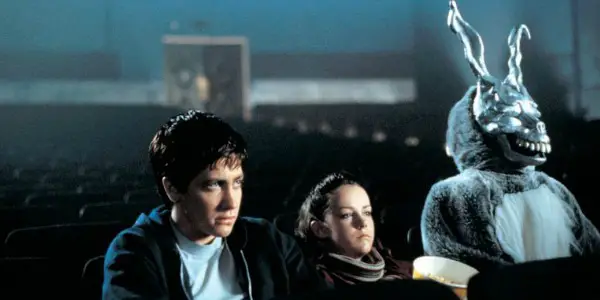
Fibonacci used an example of the mating pattern of rabbits to explain his sequence. I’ll help break it down for you:
Let us say that two newborn rabbits, one male, one female, are placed in a controlled field. Since rabbits can mate starting at the age of one month, at the end of its second month a female can produce another pair of rabbits. Let us add to the equation that our rabbits never die and that the female always produces one new pair (one male, one female) every month from the second month on. The question that Fibonacci posed was: How many rabbits would there be at the end of one year? This analogy in the film also serves as a commentary on the increasing expression of sexual promiscuity of subsequent generations of American youth, as well as the inevitable trend towards humankind’s exhaustions of the world’s natural resources as a result of overpopulation.
The Fibonacci Spiral was also referenced in the science fiction movie Dark City. In that film, a man wakes up alone in a post-apocalyptic world controlled by beings that have the ability to put entire cities to sleep and control their minds, a sociopolitical allegory that also reflects the collective automation seen in the residents of Middlesex in Donnie Darko. As Gretchen waits for the school bus, a Volkswagen Rabbit vehicle passes in front of her, foreshadowing her inevitable, fatal encounter with Frank and his friend at the end of the film. Donnie is also dressed as a rabbit in an old Halloween picture with his sister during one of the interior shots of the Darko household.
Kelly included so much foreshadowing that might seem heavy-handed on paper, but in actuality, was incredibly nuanced when transposed onto screen.
The Soundtrack’s ’80s Pop Revival
Donnie Darko reintroduced the millennial generation to ‘80s bands such as the aforementioned Echo and the Bunnymen, Joy Division, Tears for Fears, INXS, and Duran Duran. The song The Killing Moon includes the lyrics: “Fate, up against your will, through the thick and thin, he will wait until, you give yourself to him.” Though the film is about divine intervention, according to Kelly, the ending was left far more open to interpretation, as he did not want his message to be too heavy-handed. These lyrics reflect Donnie’s fatal mission as given to him by Frank.
The song Mad World, originally written and performed by Tears for Fears, was updated by composer Michael Andrews and pop singer and songwriter Gary Jules in the film’s final sequence. The Billboard hit includes the lyrics: “The dreams in which I’m dying, are the best I’ve ever had.” Donnie is not truly at peace in the film until the last sequence, when he finally knows his fate and how his actions affected the lives of the people he engaged with over the last 28 days.
Love Will Tear Us Apart by Joy Division is Donnie and Gretchen’s ill-fated anthem. It begins to play when Gretchen knocks on Donnie’s front door during his party, where she loses her virginity to Donnie. In ‘70s and ‘80s horror slasher movie canon, it is unanimously regarded that the only way for a female character to survive is by remaining a virgin. I’m serious, it’s pretty ridiculous. Kelly, a horror genre fan, plays with this trope in the film. Gretchen dies only hours after leaving Donnie’s party.
At this point, you’re probably thinking that either Kelly is a meticulous, subliminal mastermind, or that all of this supposed encrypted secrecy is just conspiracy. That is up to you.
The Final Montage Sequence and Religious Undertones
The last montage in Donnie Darko adds clarity to the entire chain of events that led up to the climax. The heterotic string is closed and the time warp has looped back to Oct. 2, just before the jet engine crashes into Donnie’s bedroom. This time, a wiser Donnie lies in bed laughing, awaiting death happily, knowing he completed his fate. Dr. Thurman wakes up in a cold sweat from a nightmare, her facial expression conveying a vague, subconscious memory of her interactions with Donnie that are now erased from spacetime.
Each character Donnie encounters over the film has yet to be changed for better or for worse as a result of their interaction with him. Kitty Farmer sits awake, disheveled, restless at what she fears might be true of Jim Cunningham. Cherita Chen rests peacefully, fantasizing about her crush, Donnie. The man who plays Frank sits beside his nightstand in a perturbed trance, as if he has already been informed of god’s plan and his fatal fate. He touches his eye, as if he vaguely remembers being shot through it by Donnie on Halloween in his bunny costume.
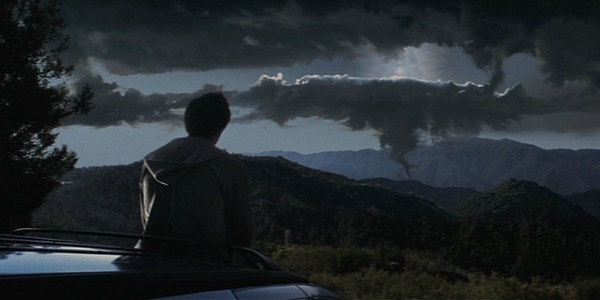
Jim Cunningham is crying in pain, consumed by the guilt of the unforgivable secret he holds. Jim represents, as Donnie calls him in the film, “the antichrist.” Though, Kelly’s vision of the antichrist is a banal one, showing a flawed human being rather than an all-powerful evil that one might see in Dante Alighieri’s Inferno. Karen Pomeroy is the only character that is sound asleep. In the film, her character, along with Gretchen and Donnie, is one of the few people that are “awake,” so to speak, detached from the autonomy of suburbia.
Alas, the last line of the movie, as the FBI and airline crew clean up the crash site, is: “All units should be back on base frequency.” Symbolically, this signifies that every person and thing touched by Donnie in the alternate time loop is back in its original place, in line with the vibrational harmonies of the universe from a dimensional standpoint. The crash happened as god originally intended it to happen; Donnie sacrifices himself for humanity, so to speak, for better or for worse, morally. Donnie, the Christ-like figure in the story, dies to appease the sins and hidden desires of the people of Middlesex.
Indeed, Kelly’s film is intended to be open to interpretation, to a certain extent, but Kelly had a clear vision for how he interpreted his plot. He combined religious context with complex scientific theories about time travel and the existence of god as told through the The Philosophy of Time Travel (which uses real-life theorems) and Donnie’s stimulating conversations with Professor Monnitoff. It is undoubtedly a film about an act of god as told from a scientific approach; after a new tangent universe, or string, was created due to the plane engine incident in the beginning, god used Donnie as a sacrificial pawn in his plan to complete this new looped string, close the tangent universe, and reset the timeline back to the original dimension.
God used Frank (Wisdom), the instrument of god in this story, as the messenger to convey this plan. Kelly also plays thoroughly with sacrilegious critiques on religion. The children attend a Catholic high school, which is intended to be more academically prestigious than the public school system, but the conservatism that these schools push onto their students spawns rebellion; in the now-famous Head Over Heals montage, students take drugs and fight each other right in front of the oblivious principal and staff.
On top of introducing the world to Kelly’s meticulously symbolic, cerebral and thought-provoking brand of storytelling, it also gave viewers a preview of his deftness for handling a camera. The unique angles, pans, glides and dolly effects that Kelly uses throughout the film add a stylistic element that accentuates its nonconformist plot. Throughout the film, Kelly manipulates time and perception with his camerawork and editing. Often times he uses slow motion followed immediately by fast motion, underscoring not only the theme of suburban automation, but also god’s control – in the context of this film – over the dimension of time and the fate of the people of Middlesex.
The theme of time travel is far more important than just a plot point in this film. It serves as an important real world forewarning, urging history not to repeat itself. Ironically, with the timeline wiped clean at the end of the film, the histories of the characters in Middlesex will continue to repeat themselves without Donnie. Donnie Darko encourages its audience to progress, ideologically, using 1988 as an example of political regression. Ironically, George W. Bush was already in office when the film was first released in theaters in 2001 and was serving his second term when the director’s cut was released in 2004.
Now, its March 31 re-release fell into the first disastrous 100 days into its most oppressive, authoritarian regime yet with the virtual unanimously loathed among world leaders, Donald Trump. Ironically, much of the Cold War hysteria placed in the film by Kelly can be seen across the concerned citizens of the United States today. The same collective dystopian unease is in the air. Perhaps the world could use a Darko-esque divine or cosmic intervention to right the course of history, to set the world’s autonomy “back on base frequency.”
Nearly 30 years after the film takes place, our world, our country, our youth are nearing a tipping point, similar to the impending event Frank was referring to throughout the film. And so, Donnie Darko, the first cult classic of the 21st century, a masterclass in assiduous filmmaking, remains one of the most relevant, urgent and timely films of the last 50 years.
Were you able to catch the 4k restoration of Donnie Darko in theaters? What is your favorite quote from the film? Do you have any interesting theories? Tell us in the comments below!
Donnie Darko was rereleased on March 31, 2017 by Arrow Films in the US, with Richard Kelly in attendance for a Q&A for selected coastal screenings, and ran through the rest of April.
Does content like this matter to you?
Become a Member and support film journalism. Unlock access to all of Film Inquiry`s great articles. Join a community of like-minded readers who are passionate about cinema - get access to our private members Network, give back to independent filmmakers, and more.
Alex Arabian is a freelance film journalist and filmmaker. His work has been featured in the San Francisco Examiner, The Playlist, Awards Circuit, and Pop Matters. His favorite film is Edward Scissorhands. Check out more of his work on makingacinephile.com!












